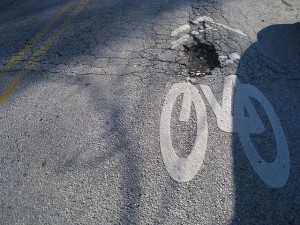In the end the vote, as usual, was unanimous.
The Los Angeles City Council voted 15 to 0 this morning, not to fix the city’s crumbling streets, but to study how to fix them.
And more importantly, how to pay for it.
The vote came on a proposal from Council Members Joe Buscaino and Mitch Englander to put a $3 billion dollar bond issue on next year’s fall ballot to repair 8,700 of the city’s 28,000 lane miles of city streets. Currently, 38% of the city’s streets are graded D or F on a typical A through F scale, and are being allowed to deteriorate because the cost of rebuilding them is too high.
That estimated cost has doubled, from $1.5 billion to $3 billion, since the city first considered fixing the streets nearly a decade ago. And it’s predicted to double again within another 10 years if nothing is done to fix them in the meantime.
The proposal, now called Save Our Streets Los Angeles, first came up early this year when the two council members suggested putting it on the May mayoral ballot. However, it was quickly pulled in the face of opposition from property owners who would have borne the $28 annual cost of the bond issue.
It also faced opposition from various other groups, including bicycle and pedestrian advocates who considered the proposal dead in the water unless it incorporated a complete streets approach that would benefit all road users, as well as fix L.A.’s 10750 miles of sidewalks, an estimated 40% of which need complete reconstruction.
However, the presentation from the two council members compared that $28 cost to the estimated $750 in additional vehicle-operating costs paid by L.A. motorists due to the poor condition of the roadways.
Of course, drivers aren’t the only ones at risk from bad roads. A pothole or crack in the roadway that might be a mere annoyance to a motorist can result in severe injury, or worse, to a bicyclist who has to swerve around it or risk falling in front of oncoming traffic after trying to ride through it.
And today’s presentation noted that the city already faces lawsuits from pedestrians injured while walking — or often clambering over — the jumble of broken sidewalks that only serve to discourage strolling through many parts of the city.
Fortunately, there’s a lot to like in the proposal to study the proposal that passed the council today.
- Long term preservation of streets to maintain an overall B grade
- Use of alternative paving materials to reduce the heat island effect
- Sidewalk and alley construction and repair, as well as possibly vacating under-used streets and alleys
- A complete streets approach to serve all road users, including motorists, transit users, bicyclists, pedestrians, wheelchair users, children and the elderly
- Possibly more Green Streets, similar to the Elmer Avenue Project in Council District Six
Of course, none of that is guaranteed to make the final ballot proposal. The current motion only says that city agencies should consider the feasibility of incorporating them into it.
Then there’s the question of how to pay for it.
The motion passed this morning instructs city agencies to study a number of financing options, ranging from government grants and borrowing against future revenues, to the previously suggested property tax increase. Along with more inventive proposals, including funding strategies that could replace declining gas tax revenues, tapping future Waste Hauling Franchise Fees, or charging fees to vehicle owners, such as a local vehicle registration fee, gas tax or tolls.
If passed — and that’s a big if, given the current two-thirds super-majority currently required to pass a bond issue — the result could be smoother, safer and healthier streets and sidewalks for everyone who lives in or moves through LA. As well as a promise of tens of thousands of new jobs to complete the task, whose salaries would benefit businesses and boost tax rolls throughout the Los Angeles area.
Of course, it all depends on what survives the city’s feasibility study, which is due back before the council by next July in order to make it onto the fall ballot.
And yes, they promise there will be many meetings in the meantime to give everyone a chance to weigh in.
You can read the full motion that passed the city council here (#23).







